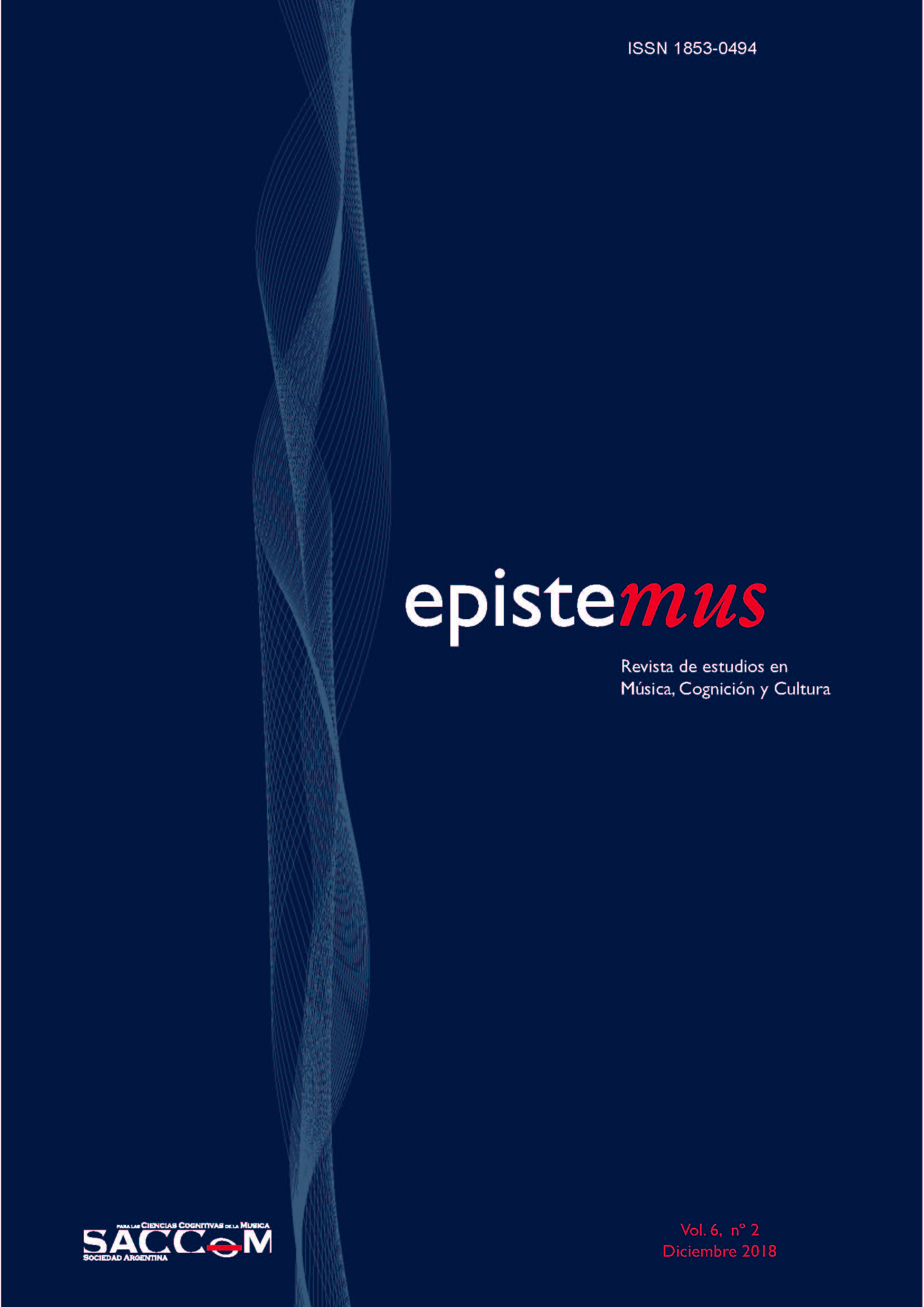Music metaphors to live by
Discourse analysis of admissions to the program of music interpretation
DOI:
https://doi.org/10.24215/18530494e015Keywords:
conceptual metaphor, music, text analysisAbstract
This paper reveals the findings of the linguistic-conceptual analysis of artistic discourse applied to texts produced by candidates to the program of the BA in Music Interpretation at Universidad Provincial de Córdoba in the diagnostic test of Foreign Language for Specific Purposes administered to 2016, 2017 and 2018 cohorts. Two linguistic approaches have been brought together: systemic-functional linguistics and the theory of conceptual metaphor belonging to cognitive linguistics, with an aim at extracting recurring patterns of metaphorical conceptualization in the definition or characterization of music. MUSIC IS LIFE emerges as the most recurrent and significant conceptual metaphor of all. Other conceptual metaphors found are MUSIC IS LANGUAGE, SHELTER, CONTAINER, AGENT, and ENTITY. The methodology applied has allowed for work with textual evidence engaging a semiotic and social dimension, to detect not only metaphors as manifested in discourse, but also those conceptual structures that are not usually perceived as metaphors, but which constitute a basic conceptual fabric that is both subjective and culturally-shared by informants.
Downloads
Metrics
References
Antović, M. (2014). Metaphor about music or metaphor in music: A contribution to the cooperation of cognitive linguistics and cognitive musicology [Metafora o muzici ili metafora u muzici: jedan prilog za saradnju kognitivne lingvistike i kognitivne muzikologije]. En M. Stanojević (Ed.) Metaphors We Research: Contemporary Insights into Conceptual Metaphor [Metafore koje istražujemo: suvremeni uvidi u konceptualnu metaforu] (pp. 233-254). Zagreb: Srednja Europa.
Butler, C. (2013). Systemic Functional Linguistics, Cognitive Linguistics and psycholinguistics. Opportunities for dialogue. Functions of Language 20(2), 185-218. doi: io.i075/fol.20.2.03.
Consejo de Europa. (2002). Marco común europeo de referencia para las lenguas: aprendizaje, enseñanza, evaluación. Madrid, Anaya. Recuperado de https://cvc.cervantes.es/ensenanza/biblioteca_ele/marco/cvc_mer.pdf en español, https://rm.coe.int/1680459f97 en inglés.
Cox, A. (2001). The Mimetic Hypothesis and Embodied Musical Meaning.
Musicae Scientiae, 5(2), 195-212. doi: 10.1177/102986490100500204.
Eggins, S. (2004). An Introduction to Systemic Functional Linguistics. London: Continuum.
Forceville, C. y Urios-Aparisi, E. (2009). Multimodal Metaphor. Berlin: Mouton de Gruyter.
Halliday, M.A.K. 1978 [2001]. Language as social semiotics [El lenguaje como semiótica social]. Buenos Aires: FCE.
Halliday, M.A.K. y Matthiessen, Christian M.I.M. (2004). Introduction to Functional Grammar, 3a ed. London: Arnold.
Igoa, J. (2010). Sobre las relaciones entre la Música y el Lenguaje. Epistemus 1, 97-125.
Jandausch, A. (24-26 de mayo, 2012). Conceptual Metaphor Theory and the Conceptualization of Music. Trabajo presentado en 5th International Conference of Students of Systematic Musicology, Montreal, Canada.
Lakoff, G. y Johnson, M. (1980). Metaphors We Live By. Chicago: The University of Chicago Press.
Lakoff, G. y Johnson, M. (1999). Philosophy in the Flesh: The Embodied Mind and Its Challenge to Western Thought. New York: Basic Books.
Lakoff, G. y Turner, M. (1989). More Than Cool Reason: A Field Guide to Poetic Metaphor. Chicago: University of Chicago Press.
Lakoff, G. (1987) [1990]. Women, Fire and Dangerous Things: What Categories Reveal about the Mind, 2a ed. New York: Cambridge University Press.
Lakoff, G. (1993). The contemporary theory of metaphor. En A. Ortony (Ed.), Metaphor and Thought (pp. 202-251). Nueva York: Cambridge University Press.
López Cano, R. (2013). El error de Descartes y las tres venganzas de René. Introducción al Dossier Cognición Musical Corporeizada. Epistemus 2, 9-21.
Mahler, C. (2018). Vínculos entre la teoría de la metáfora conceptual y el análisis sistémico-funcional en la investigación en las artes. Investiga + 1(1), 224-226. Recuperado de http://www.upc.edu.ar/wp-content/uploads/2015/09/investiga_n1.pdf
Mahler, C. (2019). “Esquematicidad Mimética en las Metáforas Multimodales: Contribuciones a la Teoría de la Metáfora Conceptual”. En C. Scotto, F. Rodríguez e I. Audisio (Comps.), Los signos del cuerpo: enfoques multimodales de la mente y el lenguaje, (pp. 113-141). Buenos Aires: UAI Editorial Teseo. ISBN 978-987-723-206-6. Recuperado de https://www.editorialteseo.com/archivos/16704/los-signos-del-cuerpo/
Martin, J. (1997). Analysing genre: Functional parameters. En J. Martin y F. Christie (Eds.) Genre and institutions: Social processes in the workplace and school, (pp. 3-39). London: Cassell: Continuum.
Peñalba, A. (2005). El cuerpo en la música a través de la teoría de la metáfora de Johnson: Análisis crítico y aplicación a la música. TRANS Revista Transcultural de Música, 9. Recuperado de https://www.sibetrans.com/trans/article/176/el-cuerpo-en-la-musica-a-traves-de-la-teoria-de-la-metafora-de-johnson-analisis-critico-y-aplicacion-a-la-musica
Rosch, E. (1978). Principles of Categorization. En E. Rosch y B. Lloyd (Eds.) Cognition and categorization, (pp. 27-48). Hillsdale, NJ: Lawrence Erlbaum.
Sloboda, J. (1991). Music Structure and Emotional Response: Some Empirical Findings. Psychology of Music 19, 110-120.
Steinbeis, N. y Koelsch, S. (2008). Comparing the Processing of Music and Language Meaning Using EEG and fMRI Provides Evidence for Similar and Distinct Neural Representations. PLOS ONE 3(5), e2226. https://doi.org/10.1371/journal.pone.0002226
Zbikowski, L. (1998). Metaphor and Music Theory: Reflections from Cognitive Science. The Online Journal of the Society for Music Theory 4 (1), 113-124.
Zlatev, J. (2005). What’s in a schema? Bodily mimesis and the grounding of language. En B. Hampe (Ed.) From perception to meaning: Image schemas in cognitive linguistics, (pp. 313–342). Berlin: Mouton de Gruyter.
Zlatev, J. (2013). The Mimesis Hierarchy of Semiotic Development: Five Stages of Intersubjectivity in Children. The Public Journal of Semiotics 4 (2), 47-73.
Downloads
Published
How to Cite
Issue
Section
License
Politica vigente desde octubre de 2019
La aceptación del manuscrito por parte de la revista implica la cesión no exclusiva de los derechos patrimoniales de los/as autores/as en favor del editor, quien permite la reutilización, luego de su edición (postprint), bajo una Licencia Creative Commons Atribución-NoComercial-CompartirIgual 4.0 Internacional (CC BY-NC-SA 4.0)
Acorde a estos términos, el material se puede copiar y redistribuir en cualquier medio o formato siempre que a) se cite la autoría y la fuente original de su publicación (revista y URL de la obra), se brinde el acceso a la licencia y se indique si se realizaron cambios; b) no se utilice el material para fines comerciales.
La cesión de derechos no exclusivos implica que luego de su edición (postprint) en Epistemus los/as autores/as pueden publicar su trabajo en cualquier idioma, medio y formato; en tales casos, se solicita que se consigne que el material fue publicado originalmente en esta revista.
Tal cesión supone, también, la autorización de los/as autores/as para que el trabajo sea cosechado por SEDICI, el repositorio institucional de la Universidad Nacional de La Plata, y sea difundido en las bases de datos que el equipo editorial considere adecuadas para incrementar la visibilidad de la publicación y de sus autores/as.
Asimismo, la revista incentiva a los/as autores/as para que luego de su publicación en Epistemus depositen sus producciones en otros repositorios institucionales y temáticos, bajo el principio de que ofrecer a la sociedad la producción científica y académica sin restricciones contribuye a un mayor intercambio del conocimiento global.

















